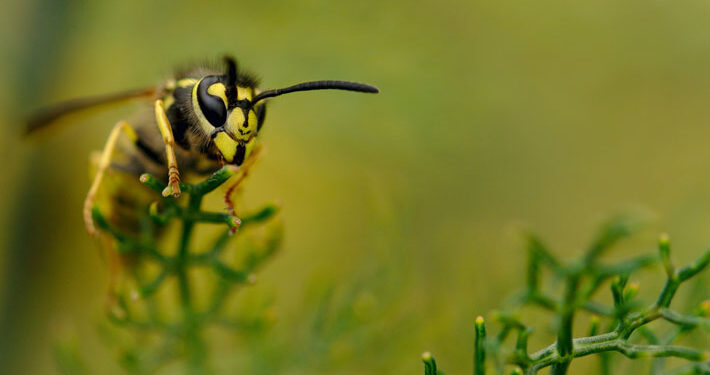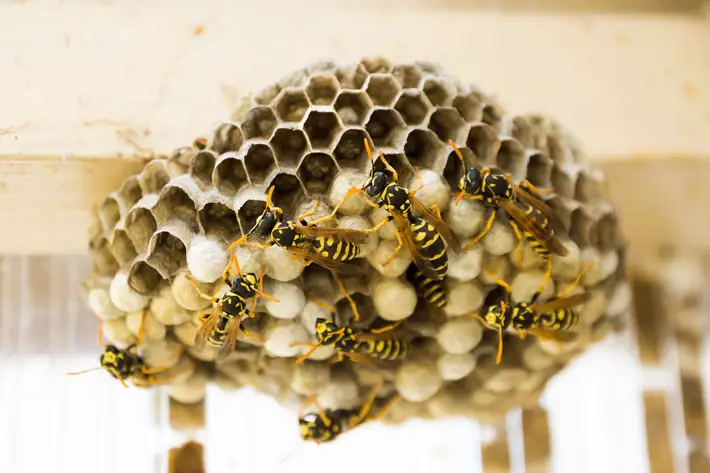How to Deal With Wasps Around Your Home

For far too many homeowners, wasps are the most dreaded household pest of all. Not only do they build unsightly nests that can cost hundreds, even thousands, of pounds to remove, but these buzzing revenge-seekers can strike fear into the hearts of your family members, roommates, or any passing neighbours.
Wasps can circle your home, hang out near your garage, or plan a sneak attack through a hole in your screen door. Known to retaliate when cornered, wasps can sting their victims multiple times per attack. Unlike a bee’s, the wasp’s stinger is resilient and can withstand the force of repeated attacks.
Despite the wasp’s rage and stinging power, there are plenty of ways to rid your home of a wasp infestation. Here’s an overview of how you can deal with wasps, as a responsible homeowner.
Signs of a wasp infestation
Physically spotting a group of wasps or wasp nest is the most telltale sign you may be experiencing an infestation. Even if you do notice a family of wasps looming around your home, it may be difficult to pinpoint the nest’s location.
To determine if your home is infested by wasps, it will require a full-scope visual inspection of your property. Typically, wasps prefer to live in wood and don’t usually bury their nests too deep into a structure, as these pests prefer to have easy outdoor access
Fortunately, wasps don’t have an affinity for household gardens, so growing your own food won’t make you more susceptible to wasp infestations.
If you aren’t going to seek out expert opinion, you’ll want to know where to look for hidden nests. Wasps are attracted to sheltered and covert areas, such as a roof’s underside, alongside an awning, under a porch, tucked in a garage corner, or even nestled in a birdhouse. Wasps build their nests by mixing chewed wood and saliva, giving their nest a crunchy, papery texture. Wasp nests resemble hanging cones, with a small hole for entry and exit at the bottom.
Once you’ve located a wasps’ nest, do not approach it. Doing so risks antagonising the wasps within the nest, which could, potentially, put you and your family at risk. Instead, note the location, and come back later when you are more prepared or have access to a pest-control professional.
What not to do
It’s tempting to mimic the “experts” on the internet who flaunt their can-do attitudes and their insane willingness to tamper with even the most threatening wasp’s nest. However, generally speaking, approaching a wasp nest without the proper equipment or safety gear can be a recipe for disaster. If you aren’t a trained professional, you may unintentionally anger the wasps, resulting in an attack — which can have extremely painful consequences.
No matter how far away you may be, do not try to blast the wasp nest with a hose. Similarly, don’t use a flamethrower or fashion a makeshift one of your own. With the help of a hose, you may be able to destroy the nest, but at a price. If nests are thoughtlessly obliterated, wasps will target their anger to the source of destruction.
If you’re brave enough to attempt a close-up attack, think twice before swinging a cricket bat or a stray broom at the net. This will simply put you in the line of fire.
What to do
First, avoid the wasp nest, and do not approach it.
Instead, take a picture (from a safe distance), so you don’t lose track of the nest’s location. You’ll want to send this photo to a professional. It will help the pest control company better determine what kind of infestation they’re dealing with. It will also guarantee that they come prepared with the proper equipment to help you deal with your pest problem.
Once you have the picture, call a professional exterminator, and explain the problem thoroughly. Depending on the situation, it may be worthwhile to host a quick tour through the rest of your property to determine whether or not you have any other wasp infestations in other locations or from another source After all if you are going to hire a professional inspect your home, it’s in your best interest to make sure you’re getting the most out of their services.
Final Thoughts
If you are looking for additional information, talk to a pest control specialist like this to learn more about how to best handle your pest infestations.
Remember, even if it is a small nest, wasps can be extremely dangerous. That’s why it is always best to leave wasp removal to the professionals. Otherwise, you may have to deal with a swarm of angry wasps and an unwelcome batch of wasp stings.










